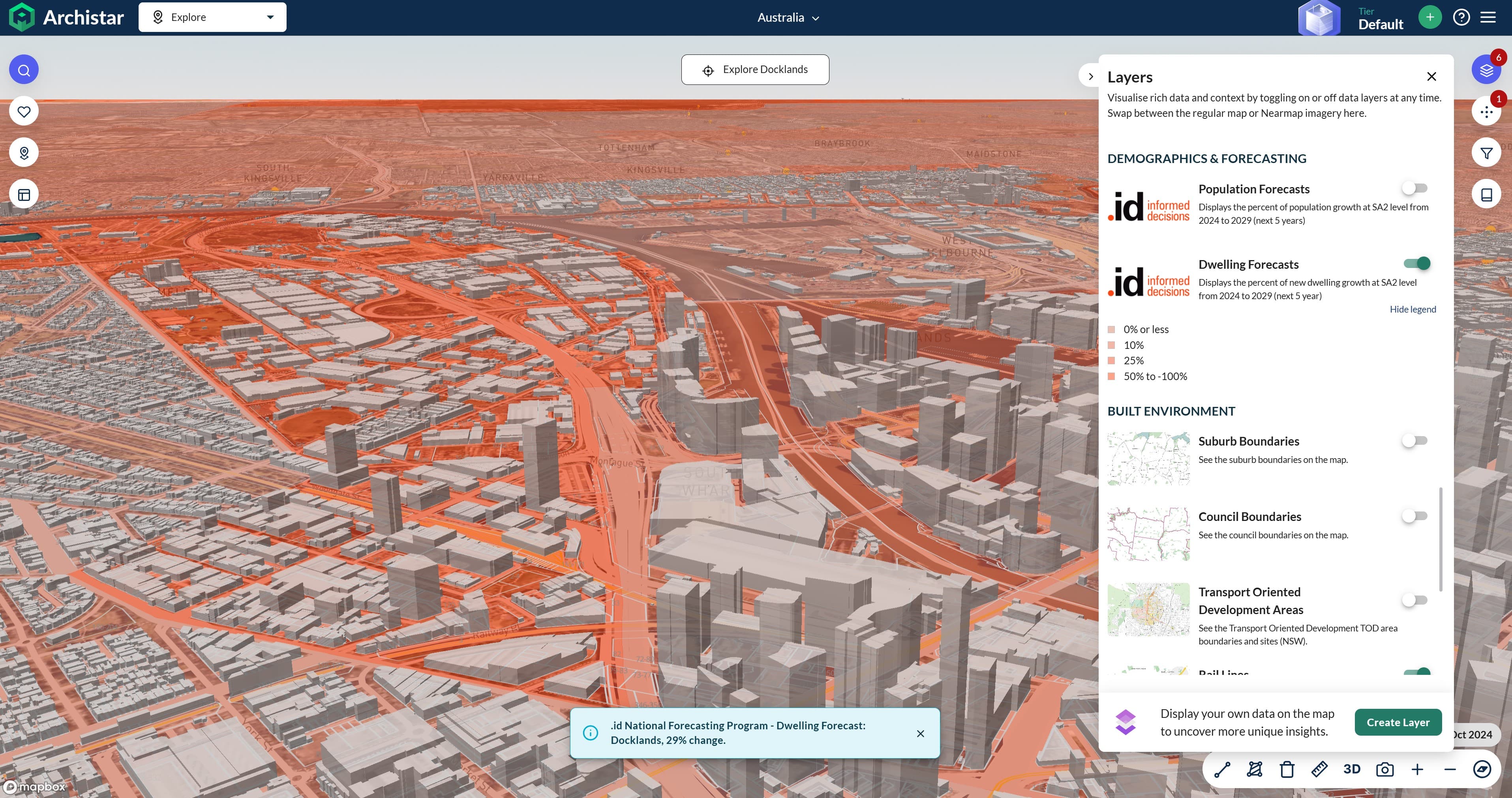In this second of a three blog series, Andrew Rossiter looks more closely at regional Australia and how COVID-19 is impacting population growth in different ‘types of places’ within it.
Using the recent release of Annual Population Estimates from the Australian Bureau of Statistics (ABS), Andrew looks at how the first few months of COVID-19 impacted Regional Australia and what it means for our Local Government population forecast assumptions.
Also, don’t miss the opportunity to hear Andrew speak about these trends at our free webinar. Watch it here.
Regional Australia is a diverse mix of places
Today we entered another lockdown in Melbourne. I think this is now the fourth where I’ll be confined to my inner city apartment, but I’m aware the impacts will be much bigger than just me. Among the emotions, it’s a timely reminder that COVID-19 is ongoing with many phases yet to run. And it’s playing out differently across Australia. What I wouldn’t give to be on the South NSW coast right now….
On the topic of COVID-19 phases, our last blog looked at the impacts that the first few months had on population growth in regional Australia and our Capital cities. While levels of growth in our capitals declined, growth in regional Australia remained resilient, with a small increase (+5.6%) compared to the previous year.
But was this growth the same across all of regional Australia?
Regional Australia is big and it’s diverse, and to help us understand how it has been impacted by COVID-19, we turn to our typology framework which defines regional Council areas as either:
- Major regional cities which provide higher-order services to a large number of wider communities.
- Rural areas that are regional inland areas, covering around 60% of Australia’s land mass.
- Coastal areas that are regional areas where most residents live by the coast.
To see which Council areas are included under each typology, click the orange link above to read the original blog.
How was population growth affected within regional Australia?
Major regional cities are the economic and population engine of regional Australia, consistently home to around 50,000 to 75,000 new residents each year.
This continued in 2019-20, with combined growth of 65,000 new residents, an increase of +0.5% compared to the previous year.
In fact, population grew in all 32 major regional cities, with the larger cities, located close to capital cities experiencing the most growth.
South East Queensland experienced significant growth, with the City of Ipswich recording the fastest growth of any major regional city growing by +7,500 residents or 3.4% over the year. The Gold Coast (+2.4%) and Sunshine Coast (+2.5%) were also in the top four fastest growing major regional cities in Australia.
Other cities experiencing significant growth in the context of COVID-19 were the large industrial cities of Geelong, Greater Newcastle councils and Wollongong/Shellharbour.
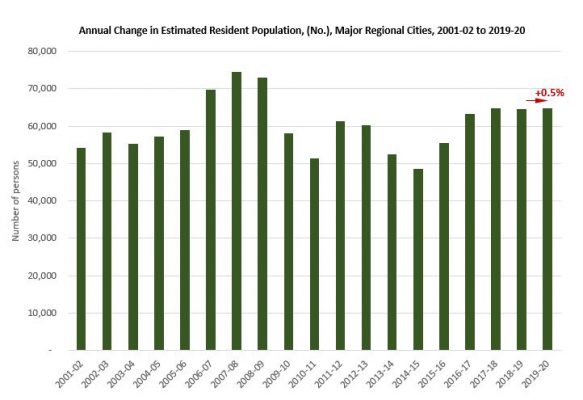
Rural areas almost doubled the growth (+47%) experienced compared to the past three years.
Interestingly half of the top ten fastest growing rural areas were in Tasmania, which retained more young adults who traditionally move to larger mainland cities.
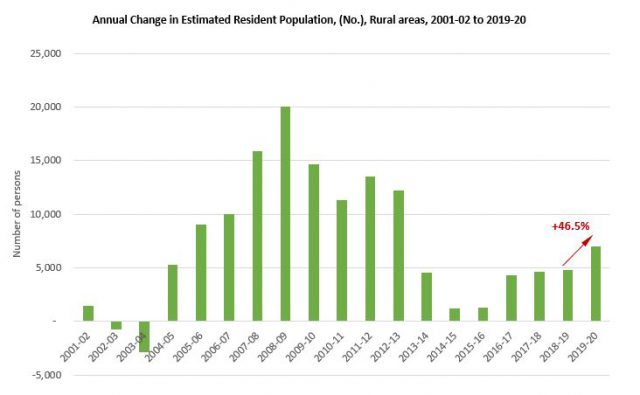
Coastal areas also experienced an increase in population growth to the tune of around +12,000 new residents in 2019-20, or +32% compared to the past couple of years.
Interestingly, some of the fastest growing coastal areas are holiday destinations with a relatively large number of holiday homes. Augusta-Margaret River (WA), Denmark (WA), Queenscliffe (Vic) and Byron Shire (NSW) all in the top five fastest growing coastal areas in Australia.
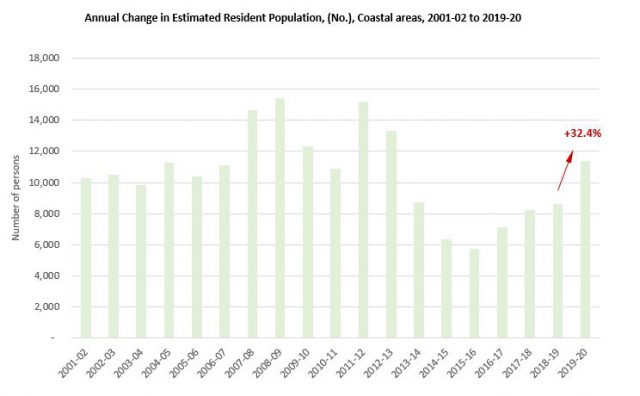
Migration is driving the change
The main driver of the change in population is net migration, that’s the total number of people moving in and moving out of an area.
The impact from three months of national border closures on overseas migration to June 2020 was felt most in major regional cities, experiencing a relative decline of -17% in the number of new overseas migrants compared to the 2018-19 period.
As a provider of higher order jobs, major regional cities are the main destination for overseas migrants looking to live in regional Australia. Historically major regional cities attract around three times more residents from overseas than rural and coastal areas combined.
Almost half of the decline in last year’s growth is attributed to the impact of COVID-19 on the large industrial cities of Greater Geelong, Greater Newcastle councils, Wollongong/Shellharbour and Gladstone.
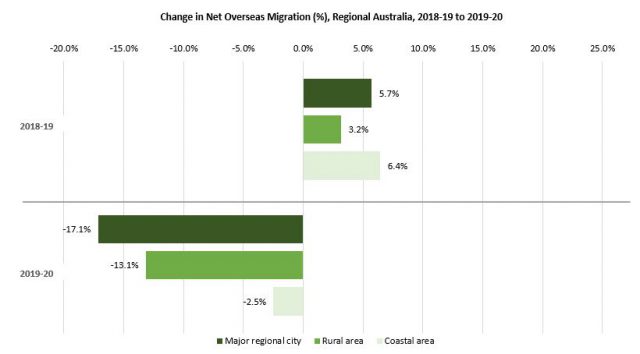
In overall terms, the impact of COVID-19 on moving WITHIN Australian (ie internal migration) was actually greater than the impact on overseas migration. And, across regional Australia the impact was positive on population growth, as many younger adults and families who would have otherwise been attracted to the Capital cities, remained living in our regions.
Coastal areas experienced the largest relative gain in internal migration with a net increase of 6,000 domestic residents, up from just 2,700 in 2018-19. This represents an overall increase of +115%, with the coastal areas that are also holiday destinations experiencing the largest increase in new domestic residents. These include Byron Shire, NSW (+590%), Colac Otway, Vic (+143%), Denmark, WA (+256%) and Queenscliffe, Vic (293%) to name a few.
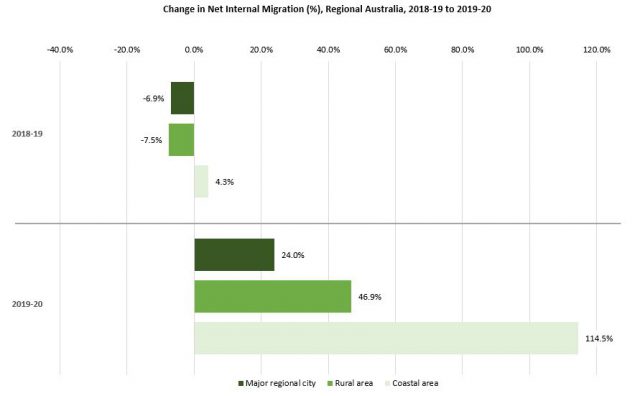
So what does this information mean for my local area population forecast?
Over the past year our Local Government population forecasting team have been sharing our thinking, learnings and hearing from clients how COVID-19 is impacting small area population forecasts. This has got us to a point where we feel we can provide an indication of the ‘most likely future’ of population outcomes even in the current highly uncertain times.
The release of the ERP is another useful source of information which continues to give us confidence that our assumptions are broadly reflective of the (continually) evolving situation; as well as assurance that the forecasts for many of our Local Government clients are tracking well.
Want to know more?
Register here for our 30 minute lunchtime webinar on June 9th, where my colleague Katie Bayley and myself will share what we have learnt about how COVID is shaping population growth in your local area.






